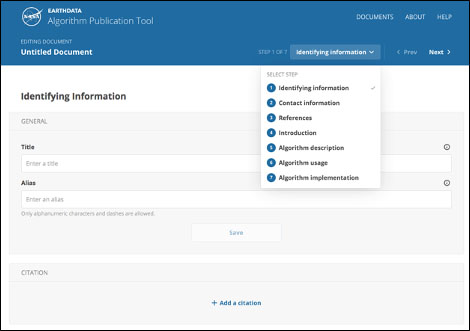NASA's Interagency Implementation and Advanced Concepts Team (IMPACT) Algorithm Publication Tool (APT) enables open, reproducible science by helping scientists write standardized, high-quality algorithm documentation collaboratively. Algorithm Theoretical Basis Documents, or ATBDs, describe the physical theory, mathematical procedures, and assumptions made for developing scientific algorithms that convert radiances received by remote sensing instruments into geophysical quantities. ATBDs help ensure reproducible science by documenting key scientific assumptions made when writing algorithms and also promote understanding of Earth observation data for users. The APT facilitates the standardized ATBD development process by providing a single authoring tool for NASA's Earth Science Division.
A prototype version of the APT was developed in 2019 and focused on developing a high quality, easy to use authoring tool. The APT is now in a second phase of development. The second phase focuses on enhancing existing authoring capabilities, establishing a centralized discovery portal for ATBDs and implementing Schema.org markups for each ATBD.
Objectives and Goals
The Algorithm Publication Tool (APT) provides the following benefits:
- The APT establishes and implements a standardized ATBD governance process. While ATBDs are critical for scientific reproducibility and for understanding data, the initiation, review, revision, and publication procedures for ATBDs have varied widely. The APT team is working with stakeholders to define a common set of roles and responsibilities for all parties involved in the ATBD authoring and approval process. In addition, the APT supports a common series of steps involved in the ATBD writing process.
- The APT facilitates the creation of a consistent ATBD by providing an end-to-end publication tool. The APT is built on a standardized ATBD template, with all information stored as metadata. For authors, the APT provides an intuitive user interface that easily supports the creation of rich content such as scientific equations, figures, and tables. The APT uses LaTeX, an open source typesetting service, to support these writing and display needs. A simplified, built-in user interface is utilized for stylizing text, inserting figures and uploading BibTeX citation files. Once a draft is finished, ATBDs can be previewed as either a PDF or as an on-demand HTML web page.
- The APT provides a centralized open discovery portal for ATBDs. A primary goal of the APT is to provide a free and open discovery portal to ensure all ATBDs are discoverable and accessible to users. The detailed scientific and technical content of ATBDs provide essential information needed to appropriately understand and use the associated data. However, finding these documents is often difficult due to a lack of a centralized ATBD discovery portal. The APT alleviates these discovery issues by providing a portal for all ATBDs published using the tool. High-quality supporting metadata, populated during the publication phase, will allow users to easily search for documents and the content within so that the most relevant information is readily discoverable. Additionally, the implementation of Schema.org markup will make ATBD content more widely searchable via more traditional search engines.
Collaboration
The APT team brings together scientists, informatics specialists, and data scientists in order to address the unique needs of this project. Earth and atmospheric scientists with expertise in data stewardship, metadata standards, and scientific writing have standardized the ATBD content and have informed the design of the user interface. Data scientists with expertise in database design, cloud architecture solutions, and user interface solutions have driven the design of the APT system.
Contact us for more information about the APT team or IMPACT.
